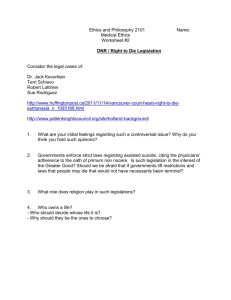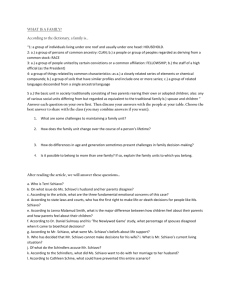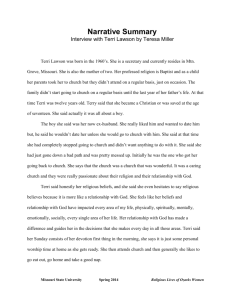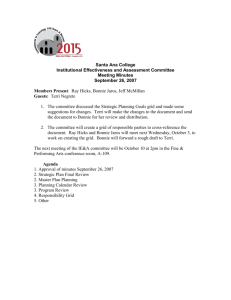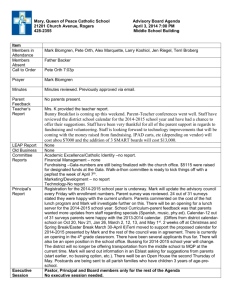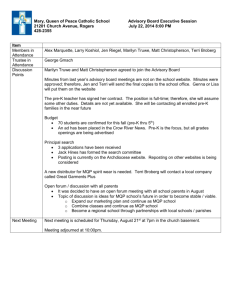Current Controversies in Clinical Ethics
advertisement
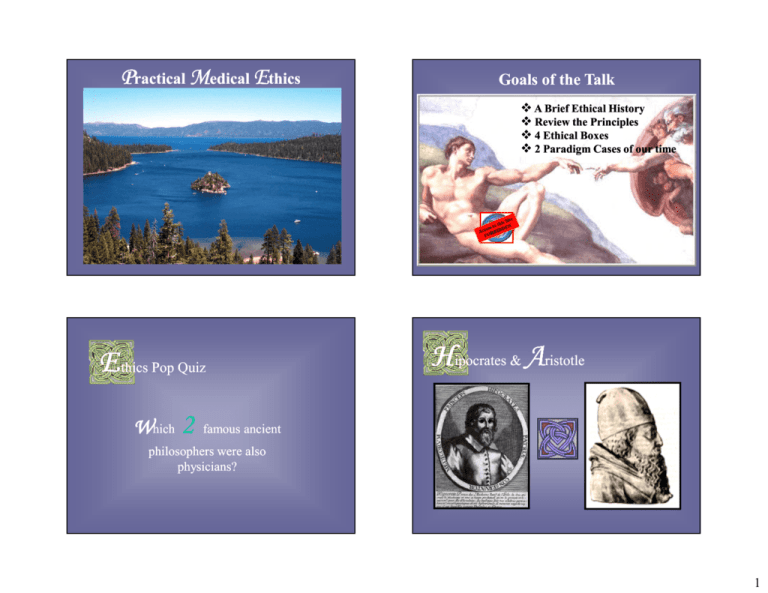
Practical Medical Ethics Goals of the Talk A Brief Ethical History Review the Principles 4 Ethical Boxes 2 Paradigm Cases of our time E thics Pop Quiz Which 2 H ipocrates & Aristotle famous ancient philosophers were also physicians? 1 E thics of Hippocratic Medicine Harnessing the principals of nature as guide to healing Be of benefit and do no harm Asclepius “Taught medicine for those who were healthy in their nature but were suffering from a specific disease; he rid them of it…then ordered them to live as usual…for those however, whose bodies were always in a state of inner sickness he did not attempt to prescribe a regime to make their life a prolonged misery…medicine was not intended for them and they should not be treated even if they were richer than Midas.” E thics of JudeoJudeo-Christian Medicine Healing comes from God through human means Care for the poor, enemies, and strangers “It is their need that cries out to you” - Plato The Republic Expansion of Medical Technology Development of antibiotics 1930’s Seattle’s “God Squad” 1962 Life Support (Karen Ann Quinlan) 1976 Artificial Organs (Barney Clarke) 1982 Societal Pressures Civil Rights / Feminist Movements 1960’s HIV Lobby 1990’s Medical Scandals Nazi Germany 1940’s Nuremberg Code 1947 Declaration of Helsinki 1964 Belmont Report 1978 Establishment of 4 Principals (Beauchamp and Childress) 1979 “A Reminder of What You Already Know” A) Beneficence B) NonNon-maleficence C) Autonomy D) Justice Created the framework for determining ethical action Tuskegee Report 1973 2 32% 16% 10% y ut on om A ic i ef al ef ic N B on m en ity 6% en ce Widely endorsed 37% Beneficience Nonmaleficience Justice Fidelity Autonomy e Cross cultural 1. 2. 3. 4. 5. st ic Ethical values not controversial Fi de l Framework for a wide variety of cases Ju Simple to remember (use?) ie nc e Usefulness of 4 Principals A patient was given a dicloxicillin for a forearm cellulitis despite having a clearly documented penicillin allergy in the chart. He returned to the prescribing physician’s office 3 days later with a cutaneous drug eruption. The physician acknowledged and apologized for the error and provided alternative therapy for the cellulitis. This is an example of the practice of which ethical principle? A patient was given a dicloxicillin for a forearm cellulitis despite having a clearly documented penicillin allergy in the chart chart.. He returned to the prescribing physician’s office 3 days later with a cutaneous drug eruption.. The physician acknowledged and apologized eruption for the error and provided alternative therapy for the cellulitis.. This is an example of the practice of which cellulitis ethical principle? A) Beneficience B) Nonmaleficience C) Justice D) Fidelity COX-2 Inhibitors and CV Outcomes Patient is a 72 yo man with bilateral knee DJD that has been treated with Vioxx for the last 3 years with good relief. He had a distant history of PUD and a previous GI bleed that was positive for H. Pylori infection-- (since treated). He arrived in infection your office saying he read in the New York Times that his medication may increase his risk for heart attack and stroke. He wants your advice. E) Autonomy 3 NSAIDS were 16th leading cause of death in US VIOXX (Refocoxib) • 1999- VIGOR (Vioxx GI Outcomes Trial) – Refocoxib roughly 2/3 fewer GI ulcerations than Naprosyn – 5X increase in CV events… – Barely mentioned in paper.. – Stated that effect due to cardio-protective naprosyn – Topol and Colleagues suggest trials to evaluate in accompanying editorial….. http://www.md.ucl.ac.be/facm/facm--conferences.htm http://www.md.ucl.ac.be/facm/facm NSAID of Action Biologic Plausibility Mechanism Refocoxib-magnitude of risk APPROVE Trial MI/CVA rate 3.5% rofecoxib ? Platelet activation ? Vascular events!!! 1.9% placebo (P<0.001) ARR=1.6 NNH= 62.5 Tens of millions of patients using this medication….. Topol, NEJM Volume 351:October 21, 2004 Number 17 4 Timing is Everything… “Dodge Ball Vioxx” Cardiovascular Outcomes FDA News Sept 30th, 2004 FDA Issues Public Health Advisory on Vioxx as its Manufacturer Voluntarily Withdraws the Product Meta-analysis of Metarandomised trials comparing rofecoxib with control Juni et al. The Lancet, Nov. 5, 2004 Merck knew in 2000 that there was an increased CV risk Merck initially cited by FDA for acting responsibly in this withdraw… http://www.fda.gov/bbs/topics/news/2004/NEW01122.html 4 years before the withdraw FDA Investigators estimate 27,000 excess MI and sudden cardiac death could have been prevented… Horton, R. The Lancet, published online Nov. 5, 2004 CLASS Study (?) Gastrointestinal toxicity with celecoxib vs nonsteroidal anti-inflammatory drugs for osteoarthritis and rheumatoid arthritis: the CLASS study: A randomized controlled trial. Celecoxib Long-term Arthritis Safety Study. Pharmacia Clinical Research and Development, 4901 Searle Pkwy, Bldg A3E, Skokie, IL 60077, USA. MAIN OUTCOME MEASURES: Incidence of prospectively defined symptomatic upper GI ulcers and ulcer complications (bleeding, perforation, and obstruction) and other adverse effects during the 6-month treatment period. RESULTS: For all patients, the annualized incidence rates of upper GI ulcer complications alone and combined with symptomatic ulcers for celecoxib vs NSAIDs were 0.76% vs 1.45% (P =.09) and 2. 08% vs 3.54% (P =.02), respectively. CONCLUSIONS: In this study, celecoxib, at dosages greater than those indicated clinically, was associated with a lower incidence of symptomatic ulcers (AT 6 MONTHS) and ulcer complications combined compared with NSAIDs at standard dosages. Issues brought forward 1- FDA is beholding to the drug industry – 1992 Prescription Drug Fee Act – $825 million from industry (’93-’01) • 4.9 million to lobby FDA in ’03 alone – Drug approval time decreased- 2714 months • Drug recalls1.56%5.35% – >50% of FDA expert panel members received honoraria from Pharma.. JAMA. 2000;284:1247-1255 5 Issues brought forward 2- Post-marketing surveillance – FDA Medwatch • depends upon voluntary reporting • http://www.fda.gov/medwatch/ – Drug Manufacturers • Less than half f/u studies promised initiated • Fox guarding the henhouse.. Issues brought forward • Direct marketing creates problems – MERCK spends $100million/year – We must figure out how to respond Our fiduciary ETHICAL responsibility – – – – refocoxib, cervistatin, troglitazone, rosiglitzone Use medications with a “track record” Report side effects to FDA Company reps=salesmen – $$ disincentive to report – Be of benefit and do no harm.. Practical Bedside Ethics Criticism of the Principles • • • • Open to interpretation Autonomy trumps all other principles Justice trumped by the wallet biopsy Hard to apply to at the bedside Clinical Ethics The 4 Box Method Medical Indications Patient Preferences Quality of Life Contextual Features - Al Jonson, Mark Siegler and William Winshade 6 4 Ethical Boxes Medical Indications Patient Preferences • Context of clinical discussion Contextual Features 4 Ethical Boxes Medical Indications • Context of clinical discussion • Dx, Tx options and goals • Pathophysiology & Prognosis • Easiest part for MD / RN Quality of Life •Intervention to improve, maintain or decrease patients QOL? • Patient’s & family’s perception • Health care team’s perception • Danger: Door Open for bias/prejudice Medical Indications • Context of clinical discussion • Dx, Tx options and goals • Pathophysiology & Prognosis • Easiest part for MD / RN • Dx, Tx options and goals • Pathophysiology & Prognosis • Easiest part for MD / RN Quality of Life 4 Ethical Boxes Patient Preferences •What are the patient’s goals/values • Adequate information/understanding • Voluntary consent, coercion? • Surrogate decision makers • Nursing/SW/Chaplaincy can help! Contextual Features Quality of Life Patient Preferences •What are the patient’s goals/values • Adequate information/understanding • Voluntary consent, coercion? • Surrogate decision makers • Nursing/SW/Chaplaincy can help! Contextual Features 4 Ethical Boxes Medical Indications • Context of clinical discussion • Dx, Tx options and goals • Pathophysiology & Prognosis • Easiest part for MD / RN Quality of Life •Intervention to improve, control or decrease? • Patient’s & family’s perception • Health care team’s perception • Danger: Door Open for bias/prejudice Patient Preferences •What are the patient’s goals/values • Adequate information/understanding • Voluntary consent, coercion? • Surrogate decision makers • Nursing/SW/Chaplaincy can help! Contextual Features • Describes “outside influences” on care • Financial, social, cultural • Danger: Guard against Prejudice • Danger: Macro applied on micro scale 7 Terri Schiavo November 1984 Terri (nee Schindler) and Michael Schiavo are married. February 25, 1990 Terri Schiavo suffers cardiac arrest, apparently caused by a potassium imbalance and leading to brain damage due to lack of oxygen. She was taken to the Humana Northside Hospital and was later given a percutaneous endoscopic gastrostomy (PEG) to provide nutrition and hydration. May 12, 1990 Terri Schiavo is discharged from the hospital and taken to the College Park skilled care and rehabilitation facility. Terri Schiavo May 1998 Michael Schiavo petitions the court to authorize the removal of Terri Schiavo’s PEG tube; the Schindlers oppose, saying that Terri would want to remain alive. The court appoints Richard Pearse, Esq., to serve as the second guardian for Terri Schiavo. June 18, 1990 Court appoints Michael Schiavo as guardian; Terri Schiavo’s parents do not object. December 20, 1998 Richard Pearse, Esq., issues his report in which he concluding that Terri Schiavo is in a persistent vegetative state with no chance of improvement and that Michael Schiavo’s decision-making may be influenced by the potential to inherit the remainder of Terri Schiavo’s estate. September 1990 Terri Schiavo’s family brings her home, but three weeks later they return her to the College Park facility because the family is “overwhelmed by Terri’s care needs.” February 11, 2000 Judge Greer rules that Terri Schiavo would have chosen to have the PEG tube removed, and therefore he orders it removed. Terri Schaivo Terri Schiavo April 12, 2001 The Schindlers petition the Florida Supreme Court to stay the removal of Terri Schiavo’s PEG tube. April 18, 2001 The Florida Supreme Court chooses not to review the decision of the 2nd DCA. April 23, 2001 Justice Anthony M. Kennedy of the United States Supreme Court refuses to stay the case for a review by that Court. April 24, 2001 By order of trial court Judge Greer, and upon issuance of a 2nd DCA mandate, Terri Schiavo’s PEG tube is removed, replaced one week later on appeal September 17, 2003 Judge Greer orders the removal of the PEG tube to take place on October 15, 2003. October 20, 2003 The Florida House of Representatives passes a bill, “Terri’s Law,” that allows the governor to issue a “one-time stay in certain cases.” October 21, 2003 The Florida Senate passes the bill; Governor Bush issues an executive order directing reinsertion of the PEG tube March 20, 2004 Pope John Paul II addresses World Federation of Catholic Medical Associations and Pontifical Academy for Life Congress on "LifeSustaining Treatments and Vegetative State: Scientific Advances and Ethical Dilemmas." September 23, 2004 Florida's Supreme Court, unanimously affirming the trial court order, declares "Terri's Law" unconstitutional 8 Terri Schaivo January 24, 2005 The United States Supreme Court refused to review ruling overturning “Terri’s Law” as unconstitutional. March 17, 2005 For third time the PEG tube is removed March 21, 2005 Shortly past 12:30 a.m., the U.S. House of Representatives votes 203-58 to suspend its rules and pass S.686. President Bush signs it. March 22, 2005 Federal District Court Judge Whittemore refuses to order re-insertion of the PEG tube. March 24, 2005 The U.S. Supreme Court refuses to hear the Schindlers’ case. The Schiavo Case 3 Important Views 1- Medical/Ethical/Legal 2- Theological 3- Political Application of 4 boxes March 31, 2005- 9:05 AM- Terri Schiavo dies- 21 years after her accident Post-Cardiac Arrest Rule The Schiavo Case 1- Medical Indications -what % of patients survive cardiac arrest on TV? • 225,000 patients have sudden cardiac death in US • 50% arrive at hospital alive – 80% are in post-arrest coma, 14% survive to discharge – NEJM. 2001;334:1304-13 • 5 clinical signs predict poor outcome absent corneal reflexes at 24 hours (LR, 12.9; 95% confidence interval [CI], 2.0-68.7) absent pupillary response at 24 hours (LR, 10.2; 95% CI, 1.848.6) absent withdrawal response to pain at 24 hours (LR, 4.7; 95% CI, 2.2-9.8) no motor response at 24 hours (LR, 4.9; 95% CI, 1.6-13.0) no motor response at 72 hours (LR, 9.2; 95% CI, 2.1-49.4). – Booth et al. JAMA. 2004;291:870-9 9 Persistent vegetative state Terri’s Medical Condition •EEG Flatline •Multiple Evaluations •PVS •14 years duration Normal Head CT VS. Terri’s CT The Schiavo Case 1- Medical Indications - No chance for clinical improvement 2- Patient Preferences Loss of cortical function with maintenance of brainstem function-- eyes open unconsciousness with physiologic function sleep/wake cycles but no awareness of self or environment. Neurology, 1989;39, 125125-126 Coma – profound unconsciousness caused by disease, injury or sleep • 210 patients with anoxic brain injury post arrest • 134 (64%) died in the first week • 27 (13%) were discharged to free living • All but four improved by two weeks - Levy, et al JAMA May 1985 Patient Preferences • Competence – “A sufficiency of means for the necessities of life” – Legally is court determined • Capacity – “The faculty for treating, experiencing or appreciating” Clinical judgment Specific to making medical decisions Medically “incapable” of decision Terri did not have capacity 10 Surrogate Decision Makers Who chooses if no documentation exists? Spouse, Adult Children, Parents, Siblings, 2nd, 3rd • Substituted judgment Knowledge from the patient Knowledge about patient Patient’s best interest Quality of Life Futility “Leaky, hence untrustworthy, in vain: The Schiavo Case 1- Medical Indications - No chance for improvement 2- Patient Preferences -Legal Precedent with Husband 3- Quality of Life Quantitative Futility Likelihood that a medical intervention will achieve its desired ends falls below a threshold considered minimal 1%-- but beware cost considerations 1% failing of the desired effect through an intrinsic defect” Focus is on intervention not patient, society or other factors Qualitative Futility Whenever a man suffers an ill which is too strong for the means at the disposal of medicine, he surely must not even expect that it can be overcome by medicine Quality of outcome associated with an intervention falls well below a threshold considered minimal Value laden and threshold debatable Hippocratic Writings - Schneiderman Schneiderman,, Jecker, Jecker, and Jonson Annals of Internal Medicine 112, 1990: 949949-954 Blue study drug example 11 The Schiavo Case 1- Medical Indications - No chance for improvement 2- Patient Preferences -Legal Precedent with Husband 3- Quality of Life - Interventions will not improve 4- Contextual Features - Legal, Theological, Political Theological Pope John Paul II, March 2004 “The sick person in a vegetative state, awaiting recovery or natural end, still has the right to basic health care (nutrition, hydration, cleanliness and warmth). Administration of water and food, even in artificial means, ..is natural, not a medical act. …should be considered ordinary and proportionate care.” Legal- PVS statutes • 1976- Karen Ann Quinlan- post OD – NJ Supreme Court- “if there is no reasonable possibility returning to a cognitive, sapient life,” life sustaining treatment can be removed. – Here asc with ventilators – Began “living will” movement • 1990- Nancy Cruzan- post MVA – Cruzan vs. State of Mo. – US Supreme Court- Tube feedings can be stopped if surrogates produced “clear and convincing evidence” that she would refuse. – “no legal distinction between artificial food/fluids and other interventions (ventilators). Politics • Then President Bush. "I urge all those who honor Terri Schiavo to continue to work to build a culture of life, where all Americans are welcomed and valued and protected especially those who live at the mercy of others.”.. • Florida's governor, Jeb Bush, "Her experience will heighten awareness of the importance of families dealing with end-of-life issues, and that is an incredible legacy." 12 Lesson’s to be learned • • • • Thank you for your attention All Week!! Apply the 4-Boxes Encourage patients to discuss beforehand Encourage living wills Apply the rules of substitute judgment – Shared decision making – Involve experts with conflict • Appreciate the opinions of others 13
